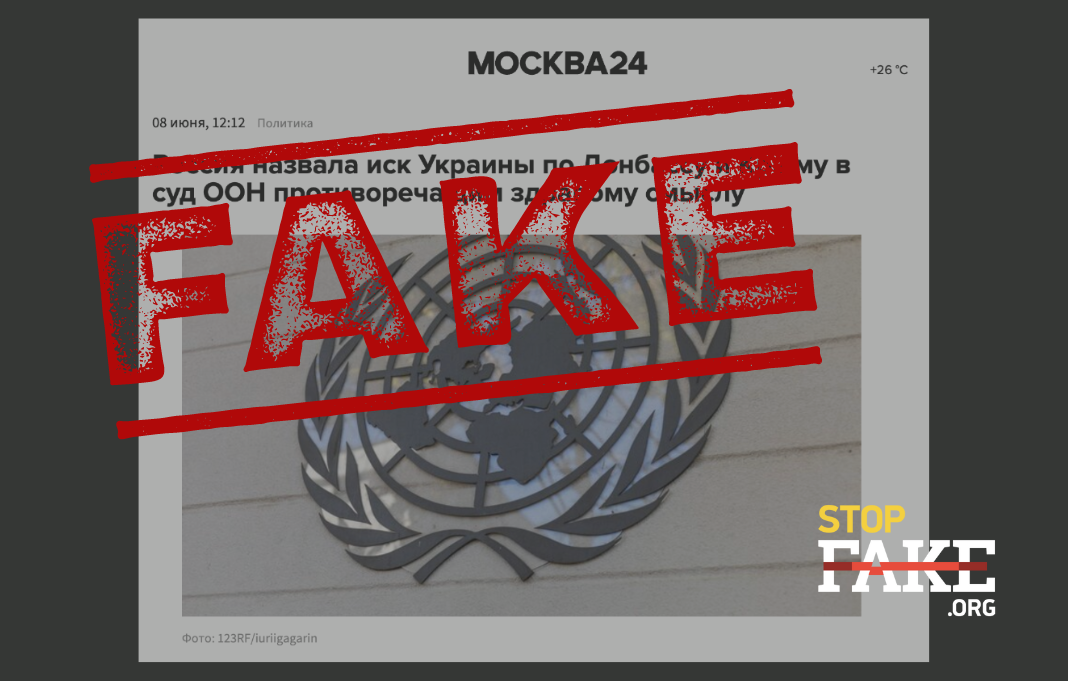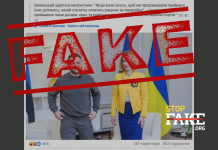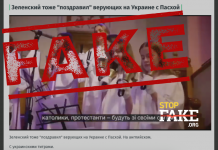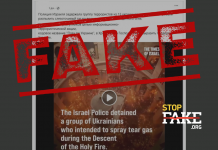In the beginning of June the International Court of Justice held public hearings on the merits of Ukraine’s case against the Russian Federation. Predictably, the Russian side brought up its usual propaganda narratives about Ukraine – how “Nazi groups” allegedly came to power in Kyiv, and “shelled Donbas” for eight years and violated the rights of the Russian-speaking population, as well as the stale Kremlin narratives about the downing of the flight MH17 passenger plane. After analyzing the Russian defense team’s speeches at the hearing, our StopFake factchecking team prepared a short list of the craziest Russian fakes – from Russia’s downing of flight MH17 to the shelling of Mariupol and Volnovakha in 2014-2015, and the rights of indigenous peoples of occupied Crimea.
Last week hearings on the merits of Ukraine’s International Court of Justice (ICJ) lawsuit against Russia ended. The court is currently hearing two complaints that Ukraine filed in 2017. The first case alleges that since 2014 Russia has intensified its interference in Ukraine’s internal affairs by financing terrorist acts, fomenting and supporting anti-government armed groups in eastern Ukraine. The second case concerns the seizure of Crimea, Russia’s organization of an illegal “referendum” there in an atmosphere of violence and intimidation against non-Russian ethnic groups. Ukraine maintains that the Russian Federation has violated the International Convention for the Suppression of the Financing of Terrorism and the International Convention on the Elimination of All Forms of Racial Discrimination. On February 27, 2022, Ukraine filed another lawsuit against the Russian Federation concerning Russia’s violation of the Convention on the Prevention and Punishment of the Crime of Genocide.
In the hearings representatives of Ukraine and Russia briefly outlined their claims and provided evidence. These hearings were held publicly, full video recordings of the proceedings are available on the International Court of Justice website along with the full transcript of the hearing, including all procedural documents (the statement of Ukraine and the review of the Russian Federation with annexes in four volumes on the financing of terrorism and in fourteen volumes on racial discrimination, etc).
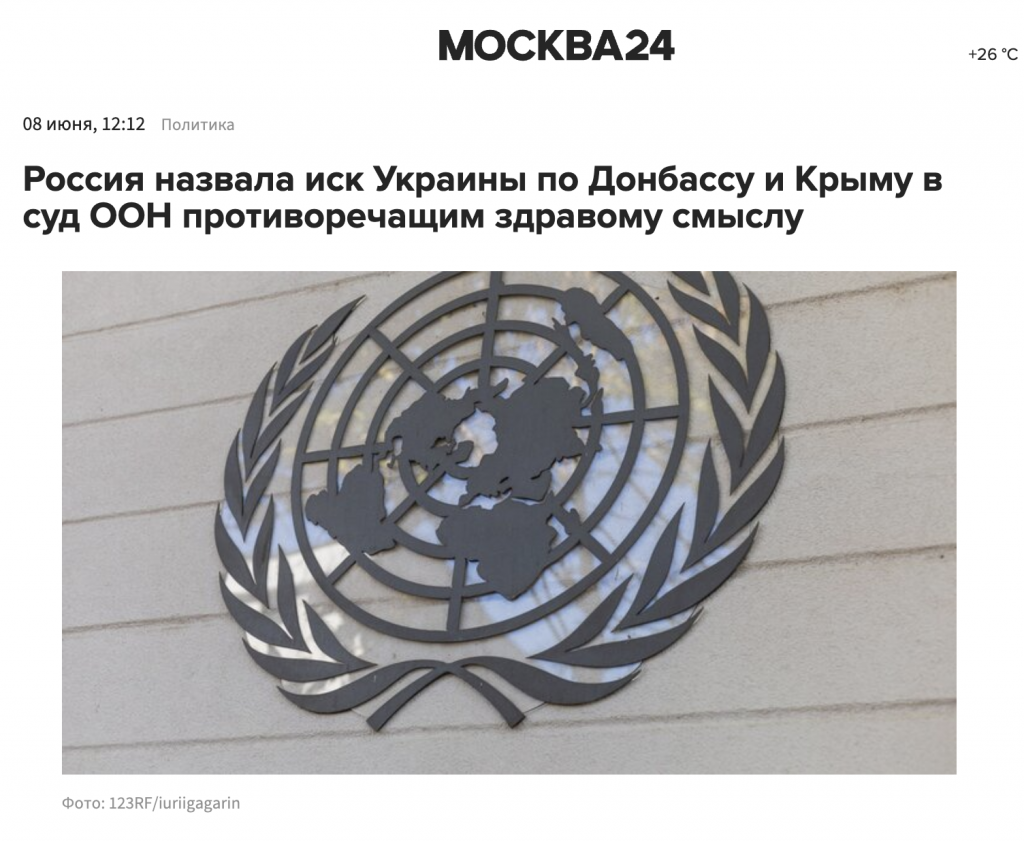
Screenshot – m24.ru
Along with diplomats, the Ukrainian delegation also included specialists from the Ukrainian General Prosecutor’s Office, Ukraine’s Security Service, international lawyers, the Chairman of the Crimean Tatar Mejlis Refat Chubarov and Orthodox Church of Ukraine Metropolitan Klyment of Simferopol and Crimea. In his opening speech, Anton Korynevych, Ukraine’s representative in the ICJ stressed that Russia regularly demonstrates disregard for international law and human rights in general.
“Ukraine came to this court to protect the fundamental rights of its people. Thousands of innocent Ukrainians have already suffered deadly attacks from Russia, millions of people remain under imminent threat. The daily life of these people has been destroyed, and their rights have been grossly violated by the Russian Federation,” Anton Korynevych said at the opening of the court session.
Ukraine’s legal representatives also presented to the court a list of obligations that Russia is bound by under international agreements and conventions, provided evidence of Russia’s financing of terrorist groups and weapons supply, including those that led to the downing of the MH17 passenger plane, as well as evidence of Russia’s systematic policy of oppression of the indigenous peoples of Crimea.
As for the Russian side, Russian representative Alexander Shulgin said that Ukraine’s claim should be rejected as it allegedly contradicts “common sense”.
“Ukraine’s claim is not just inadmissible, it is based on an incorrect interpretation of the law, contradicts common sense, is based either on false factual data or contradicts the Ukrainian position,” Shulgin said, and traditionally repeated key propaganda narratives about Ukraine:
• a “coup d’état” took place in Ukraine and “Nazi groups” came to power;
• Ukraine has been “shelling Donbas” for 8 years;
• Ukraine is a terrorist state;
• Ukraine violates the rights of the Russian-speaking population;
• The Joint Investigation Team (JIT) fabricated an investigation about the crash of the Boeing 777 scheduled flight MH17 near Donetsk.
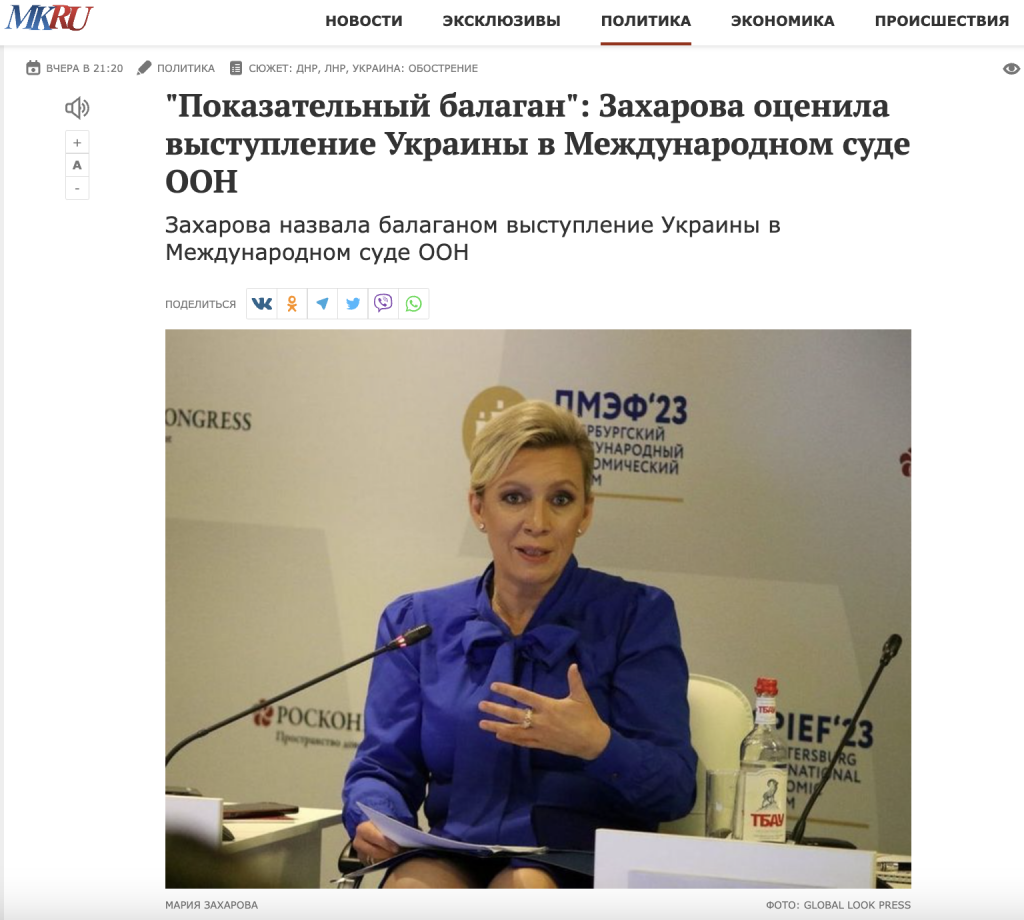
Later, Russia’s Foreign Affairs Ministry spokeswoman Maria Zakharova declared that attempting to prove that Moscow is trying to “destroy Ukrainian identity with terrorist methods,” Ukraine staged a “demonstrative farce” in the International Court of Justice. She said that in response, Russian representatives “reasonably demonstrated the baselessness of Ukraine’s claim” and also “presented the neo-Nazi nature of the current Kyiv regime in detail.” Here are the five most egregiously outrageous fakes the Russian side presented in their arguments.
Fake 1: The investigation into the MH17 crash is biased. Russia was not allowed to participate in the Joint Investigation Team probe. A Ukrainian Buk missile system, from which the fatal missile destroying MH17 was launched, was in the area of the crash.
Russian propagandists repeat this narrative on a regular basis. In fact, it was Russia itself that refused to participate in the joint investigation, saying it was conducting its own inquiry. In September 2014, Russian Foreign Minister Sergei Lavrov stated that a Russian representative was participating in the work of the international experts investigation team.
Moscow’s claims that the West is “ignoring” Russian evidence against Ukraine are also untrue. In September 2018, Russia sent information to the Joint Investigation Team (JIT) claiming that the missile, fragments of which were found near the crash site, ended up in Ukraine after the collapse of the Soviet Union and was not based in Russia. Investigators dismissed this Russian claim. “From the very beginning of the investigation until today, the JIT has always carefully analyzed and processed all information provided by the Russian Federation,” the investigation team in the Netherlands said. “In doing so, the JIT found that the information the Russian Defense Ministry previously presented to the public and provided to the JIT, was factually inaccurate on several counts.” Dutch prosecutors analyzed more than 2400 photographs of both Ukrainian and Russian Buk systems. They did not find any evidence that confirmed the presence of a Ukrainian Buk in the area of the plane crash on July 17, 2014. On March 9, 2020, the Dutch prosecutor’s office announced that it had checked all alternative versions of the plane crash, namely, that the plane crashed as a result of an explosion on board, as a result of a collision with a fighter jet and as a result of an attack by the Ukrainian Armed Forces.
The JIT investigation showed that the flight MH17 was shot down by a 9M38 series missile, which is used by the Buk anti-aircraft missile system. This missile system was delivered from Russia to Russian militant controlled territory and was launched from the territory of the so-called Donetsk People’s Republic. An investigation by the independent group Bellingcat, which the Russian representative in court called “a cell of the British special services,” confirmed this conclusion.
On June 17, 2021, the Dutch prosecutor’s office in the District Court of The Hague provided additional evidence of the Russian missile launch. This is the testimony of eight people who heard or saw the Buk missile flight, and twenty witnesses who saw missile traces in the sky and observed parts of the aircraft falling from the sky. Investigators also provided satellite images confirming the testimony of these witnesses. Russian militants’ intercepted negotiations confirm the JIT version of the investigation, how the Buk was brought in from Russia and returned back from territory that was not controlled by Ukraine, and the militant commanders’ reaction and further response plans. Fragments of the Buk missile were found during the autopsy of of crew members’ bodies and in one of the cockpit window openings. The missile has a unique sequence number. According to the JIT, the flight MH17 Boeing aircraft was shot down by a Russian air defense system assigned to the 53rd Kursk anti-aircraft missile brigade.
Fake 2: Ukraine has shot down passenger planes before, and then, as now, was never punished.
In another attempt to shift the blame for the MH17 crash to Ukraine, the Russian representative in court announced that the Ukrainian military had allegedly previously shot down a passenger airliner. Then, as now, Ukraine was not punished for this, he said. This is a reference to the crash of Siberia Airlines Flight SBI-1812 from Tel Aviv to Novosibirsk, a TU-154 airplane (tail number RA-85693) which crashed in the zone of Ukrainian-Russian military exercises on October 4, 2001, killing 66 passengers and 12 crew members. The Russian-created commission said the cause of the crash was “the destruction of the aircraft as a result of explosive damage.” In 2002, a Moscow-based commission of the Interstate Aviation Committee (IAC) ruled that the aircraft was most likely accidentally hit by a Ukrainian S-200 air defense missile. Leonid Kuchma, who was President of Ukraine at the time, agreed to pay compensation to the relatives of the victims, but legally Ukraine did not admit responsibility for the crash. In addition, further investigations showed that the IAC reports were biased and the cause of the crash could not be a Ukrainian air defense missile.
Some context is in order here. In October 2001, joint Ukrainian-Russian military air-defense exercises were being held at the 31st Russian Black Sea Fleet Research center training ground on Cape Opuk near Kerch, Crimea. During the training exercises missiles from S-200, S-300, S-125, as well as SAMs, Buk and Kub systems were fired. The targets were unmanned aerial vehicles. According to the Russian version, Flight SBI-1812 accidentally found itself in the center of the training target area and was moving at a similar speed as the target, resulting in its being detected by a Ukrainian S-200V radar system and taken as the main target. However, the Ukrainian S-200V air defense missile uses a passive (heat seeking) missile targeting system, and therefore could only hit the aircraft if the ground locator illuminated the target. But, as the investigation established, three minutes before the explosion, the Ukrainian radar equipment was turned off. That is, the Ukrainian S-200 air defense missile was not aimed at a civilian aircraft or had already hit the training target.
Moreover, according to data from a radar station in the southern Russian Black Sea town of Gelendzhik, on October 4, 2001, an unknown object was observed moving towards Flight SBI-1812 at a distance of 49.9 km 30 seconds before the aircraft crashed. An investigation by the Kyiv Scientific Research Institute of Forensic Expertise showed that this object could not have been be a Ukrainian S-200V missile, since technically it is not able to cover a distance of 50 km in such a short time. During the October 10, 2001, session of the Ukrainian parliament, Ukraine’s then Defense Minister Oleksandr Kuzmuk pointed out that the distance from the launcher to the passenger aircraft exceeds the maximum range of this particular missile.
In addition, the Kyiv Scientific Research Institute of Forensic Expertise investigation found that no fragments resembling missile wreckage were found in the cabin of the airplane or around it, and the Russian side did not provide reliable radar data with missile markings near the aircraft. Furthermore, no flight recorders that could clarify the circumstances of the disaster were ever found. The version that a Ukrainian air defense missile brought down Flight SBI-1812 is further refuted by the fact that no traces of RDX explosive were found on the fragments of the crashed plane of (this type of missile uses an explosive that consists of 80% RDX and 20% TNT). The Russian side only presented fragments with traces of TNT. The conclusions that the Kyiv Scientific Research Institute of Forensic Expertise presented to the Kyiv Pechersk District Court during the trial between Siberia Airlines and Ukraine’s Defense Ministry in 2007, completely refuted the Russian version of a Ukrainian missile hitting the Siberia Air Lines flight.
It should also be noted that the plane crash occurred on Russian Federation territory. Ukrainian authorities had closed Ukrainian airspace in the area of the training exercises, but Russia did not close its airspace over its territory where the exercises were being conducted. It is highly likely that a Russian air defense system located on the Black Sea reacted to the Tu-154M aircraft, as to an aircraft violating the state border of Russia.
Fake 3: Ukraine is “fully responsible” for the civilian casualties from the shelling of Mariupol by the so-called Donetsk People’s Republic (DPR) forces on January 24, 2015, while the Ukrainian military “hid behind civilians.”
The blame for civilian casualties sustained on January 24, 2015, lies entirely with the Russian Federation. International investigators from the Bellingcat group and the Ukrainian Security Service proved that the shelling of Mariupol on January 24, 2015, was carried out by regular Russian military, taking the lives of 30 civilians, and injuring 118.
The OSCE Special Monitoring Mission established that the Skhidny region was shelled from territory controlled by the militant DPR forces. Based on shell crater analysis, the SMM established that Grad missiles were fired from the north-east, near the village of Zhovtneve, and Uragan missiles – from the east, the area around the village of Zaichenko. Human Rights Watch also concluded that Mariupol was shelled by DPR militants controlled by Russia.
On May 7, 2018, the Ukrainian Security Service released investigation materials proving the direct involvement of the Russian military in the shelling of the Skhidny Mariupol neighborhood.
“From the territory of Russia, the operation was led by Major General Stepan Yaroshchuk, the Chief of the Russian Federation Southern Military District Missile and Artillery forces. In temporarily occupied Donetsk, the shelling was directed by Russian Armed Forces Colonel Alexander Tsaplyuk, code name Gorets. Russian Army Lieutenant Colonel Maxim Vlasov, code name Yugra, coordinated the battalion action. SBU investigators established that the 200th Pecheng Separate Motorized Rifle Brigade and the 2nd Guards Taman Motorized Rifle Division (former 5th Separate Guards Taman Motorized Rifle Brigade) were directly involved in the shelling. “Thanks to careful work, we managed to record and document minute by minute, how Russian units crossed the Russian-Ukrainian border and their path to the terrorists’ positions from which Mariupol was shelled,” said Ukrainian Security Service chief Vasyl Hrytsak.
This is confirmed by an independent investigation by the Bellingcat research group. According to Bellingcat’s findings, nine Russian officers were directly involved in the shelling, a general, two colonels and three lieutenant colonels. Two other Russian generals were indirectly involved in the shelling: they participated in the selection and appointment of Russian artillery specialists to senior positions in the Russian hybrid forces in eastern Ukraine. The main defendants are Russian Armed Forces Major General Stepan Yaroshchuk and Major General Dmitry Klimenko.
Bellingcat analysts also established that the day before the shelling of Mariupol, two batteries of multiple launch rocket systems were transported to Ukraine from Russia, on the morning of January 24, 2015, they were deployed near the village of Bezimenne. After shelling Mariupol and the surrounding area, the rocket systems were returned to Russia.
It should be noted that the so-called DPR led by Russian military, used indiscriminate weapons to shell the outskirts of Mariupol, which led to the inevitable murder of many civilians. Humanitarian law prohibits the use of indiscriminate attack weapons when they can hit or affect legitimate targets and civilians indiscriminately.
Fake 4: The January 13, 2015. shelling of a passenger bus near Volnovakha was “the result of friendly fire” between the Ukrainian military. Only Ukraine is “responsible” for the shelling of the bus, it allegedly artificially created long queues at the checkpoint and mined the surrounding area.
Russia continues to push responsibility for the January 13, 2015, bus shelling at a checkpoint near the eastern Ukrainian city of Volnovakha onto Ukraine, despite numerous facts that prove the Donetsk-Zolotoustivka passenger bus was shelled by the Donetsk People’s Republic 5th Oplot Rifle Brigade.
An OSCE Special Monitoring Mission investigation showed that the cause of the tragedy was rocket fire from the north-north-eastern direction.
Screenshot – osce.org
Human Rights Watch experts, who also visited the site, concluded that the attack was carried out from a Grad multiple launch rocket system from the north-eastern direction, that is, from territories controlled by the Russian occupation forces represented by the so-called DPR.
Screenshot – hrw.org
Human Rights Watch also draws attention to the fact that immediately after the attack, DPR associated social media accounts claimed that their forces conducted a successful attack against a Ukrainian checkpoint. However, these posts were later deleted or changed.
Ukraine’s Security Service has identified the perpetrators as the artillery division of the 5th Oplot motorized rifle brigade under the command of Russian Colonel Anatoly Sinelnikov. The leader of the attack is the “Hell’s Angels” rocket battalion commander Yu. M. Shpakov.
The Russian representative’s claim to the International Court of Justice that Ukraine allegedly “artificially created queues at the checkpoint” and “mined everything around” is also an outright lie.
The checkpoint near Volnovakha was the main checkpoint on the road between Donetsk and Mariupol. It was not a military target, as the Russian side claims, only civilian vehicles moved through this checkpoint, and this fact was widely known in the DPR. This checkpoint was indeed often very busy. According to Ukrainian legislation, vehicles entering Ukrainian controlled territory were subject to personal identity checks and vehicle and baggage inspections. If everything was in order, each vehicle was issued a ticket for further travel into Ukrainian territory. Upon return, the issued ticket was checked, and the vehicle was allowed to travel back into Russian militant controlled territory. However, according to checkpoint webcam footage, on January 13, 2015, the day of the attack, there weren’t any long queues at this checkpoint. The video shows civilian cars passing through the checkpoint and several cars parked at the entrance.
Immediately after the terrorist attack, Russian propaganda began to spread disinformation claiming that the bus could have been hit by fragments of a land mine laid near the checkpoint. However, this version was completely refuted. Human Rights Watch reviewed the damage to the bus and concluded that it was consistent with a Grad high-explosive fragmentation warhead missile attack. Ukrainian military personnel at the checkpoint told Human Rights Watch that no antipersonnel mines were present near the checkpoint, only flares and signs were used along the road to prevent people from veering off the road into the surrounding field.
As a result of this checkpoint attack 12 people were killed, 18 were wounded.
Fake 5: Aftaer the “referendum” in Crimea, Russia “built new schools for Crimean Tatars and Ukrainians”
Another cynical lie the Russians pushed during the public hearings at the Court of Criminal Justice was the claim that in occupied Crimea, Russia is allegedly building and modernizing schools for Crimean Tatars and Ukrainians. Article 10 of the so-called “constitution of the Republic of Crimea” adopted on the peninsula after the Russian annexation grants Crimean Tatar, Ukrainian and Russian languages the status of official state languages. In reality however, the Russian occupation authorities are pursuing a systematic policy of oppression and assimilation of the indigenous peoples of the peninsula. According to director of the Crimean Tatar Resource Center Eskender Bariev, who is also the chairman of the Mejlis of the Crimean Tatar people Legal and Foreign Affairs Department, before the occupation there were 15 schools and 384 classes with the Crimean Tatar language instruction in Crimea. In 2021, there were only 119 such classes left. Today, there are no Crimean Tatar schools in the occupied peninsula where all subjects would be taught in the Crimean Tatar language. In September 2021, Mejlis deputy chairman Ilmi Umerov, told Krymskie Novosti that although the occupation authorities claim seven national schools, in reality, there are none left – “because instruction is conducted in Russian, and the Crimean Tatar language is studied as a subject.”
As for the situation with the study of the Ukrainian language, it is even worse. According to data for 2021, only 214 children, or 0.1% of all students, study Ukrainian in schools in the occupied Crimea. This is despite the fact that, according to Russian data, 344,515 (15.68%) ethnic Ukrainians live in Crimea. CrimeaSOS analyst Yevhen Yaroshenko said on the Dom TV channel that during the years of occupation, the number of schoolchildren studying in Ukrainian decreased by 60 times.
In 2017, the International Court of Justice ordered Russia to ensure access to education in Ukrainian, but the occupation authorities have not complied with that ruling.
The next stage of the trial will be the announcement of the verdict, which will be in 2024. The verdict of the International Court of Justice is binding. Ukrainian Foreign Affairs Ministry Ambassador-at-Large Anton Korynevych notes that although this case concerns violations committed in 2014-2015, Ukraine still has many tools: for example, the case of genocide against the Ukrainian people, the ICC arrest warrant for Russian President Vladimir Putin and his ombudsman, and in the future – the international tribunal for the crime of aggression against Ukraine, to ensure that not a single episode of Russia’s disregard for international law is left unaddressed.


